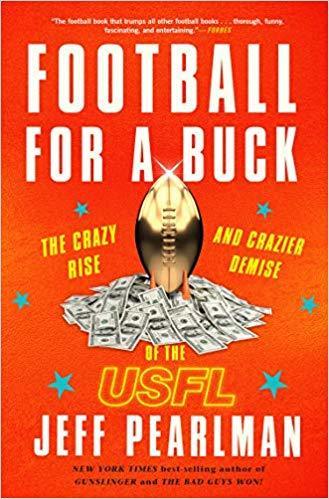
In Mike Tollin’s 2009 documentary Small Potatoes: Who Killed the USFL?, he answers the question posed by the film’s subtitle in no uncertain terms. It was, he argues, none other than Donald J. Trump. That upstart entity, the United States Football League, which played eighteen games every spring from 1983 through 1985, with varying degrees of popularity and success, might well have found a more permanent footing had it not been for the meddling of a brash young New York real estate developer. Trump, who bought the New York/New Jersey franchise, the Generals, after the league’s first season, immediately started pushing the league to switch to the fall, thus directly challenging the NFL. The other owners reluctantly agreed to the move, which, along with an ill-advised antitrust lawsuit the USFL brought against the NFL at the Donald’s insistence, contributed to the USFL’s failure.
This thesis would get no argument from Jeff Pearlman. The veteran sportswriter’s new history of the USFL, Football for a Buck, is happy to heap much of the blame on our current president. According to Pearlman’s numerous sources, Trump was, as we might expect, an aggressively unpleasant individual only interested in self-aggrandizement. Pearlman revels in creating a of portrait of the future president as a young egomaniac through juicy anecdotes, such as the revelation that he made every visitor to his office watch an eight-minute video extolling him as a “visionary builder” before they were allowed to meet with him. Not surprisingly, Trump didn’t particularly care about the long-term stability of the USFL, and his lawsuit, which seemed more an act of personal ambition than a gesture on behalf of the league’s welfare, netted a total of $1 in judgement, essentially bankrupting the enterprise.
The lawsuit itself was fueled by Trump’s desire to make it into the big leagues, according to Pearlman. He quotes George Heddelston, general manager of the USFL’s Pittsburgh franchise, who recalls a meeting with Trump and the other owners, in which Trump opened a copy of the New York Times and declared, “Look at this! Look at this! I build a skyscraper and nobody cares! I sign some obscure defensive back and I get three paragraphs in the Times. That’s why I bought the Generals!” Ultimately, Trump hoped that the lawsuit would challenge the NFL enough to force them to absorb a number of USFL teams, including his own New Jersey Generals. But he only succeeded in making the league fold and losing the only team he had.
Why did USFL’s demise feel like such a loss to those involved? For one thing, it was a blast. If the NFL was the “No Fun League”—a moniker still applied to the organization today—then the USFL was all about good times. There were colorful uniforms, raucous end-zone celebrations, and wacky promotions. In one of the more out-there gestures, one team let the spectators help out with the play-calling, holding a contest each game where fans sent in trick plays and the winner got to see their play enacted on the field. In fact, bizarreness charcterized the league, as when after the first season, two teams, the Chicago Blitz and the Arizona Wranglers, swapped almost the entirety of their rosters and coaching staffs because the owner of the Blitz lived in Arizona and didn’t want to travel to Chicago. He sold the Blitz, bought the Wranglers, and engineered the unprecedented trade, keeping most of his team intact.
Apart from the sheer entertainment the league provided, though, it also offered an opportunity for the moderately talented to fulfill their professional football dreams, a point Pearlman repeatedly makes. Although the USFL employed several well-paid marquee names (Herschel Walker, Jim Kelly, Doug Flutie) as a stab at legitimacy, the vast majority of players lacked major-league talent, as Perlman explains in one typically snarky passage. “The USFL . . . wasn’t the NFL,” Pearlman writes. “It enlisted your tired, your poor, your huddled masses, your one-armed and chain-smoking and half-blind and clinically insane.” Pearlman’s decision here to riff on Emma Lazarus’s Statue of Liberty poem, “The New Colossus,” is telling, as he ultimately posits that the USFL was a democratizing force, a vehicle for the fulfillment of various American dreams.
At the end of his book, after listing the positive impacts the USFL had on the NFL, Pearlman bemoans the losses in exactly these exalted terms. “What often gets lost in the aftermath of success stories, however, is the $1 smothering of dreams. For every Jim Kelly and Herschel Walker, there are hundreds of professional football players and coaches . . . whose careers ended the moment the USFL ceased to exist.” Pearlman seems wrapped up in this idea of dream fulfillment, but it’s hard to feel much emotion about the stalled career of pretty mediocre players. As Trump himself has shown, having a dream come true isn’t always a good thing.
Andrew Schenker lives in upstate New York.